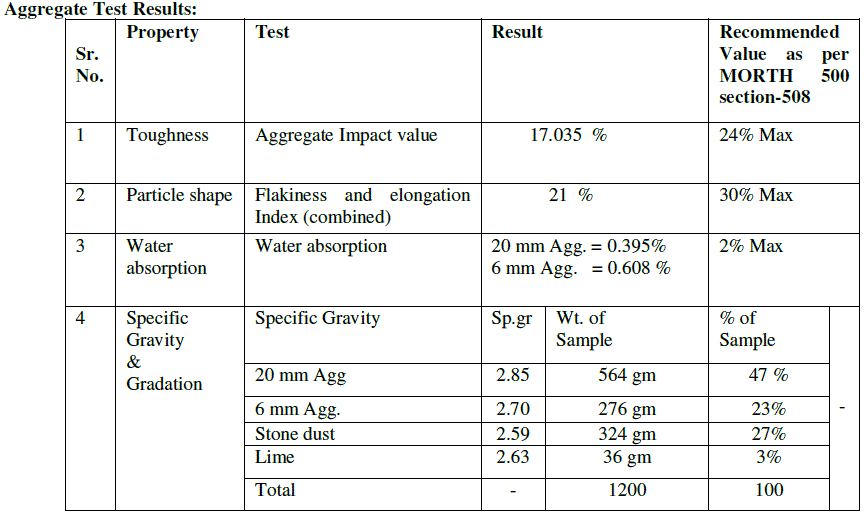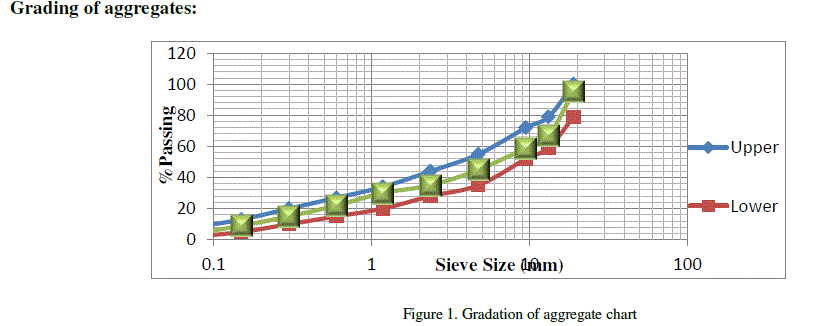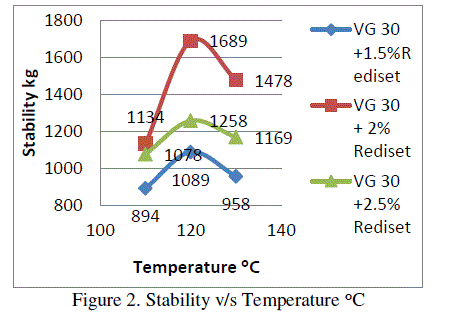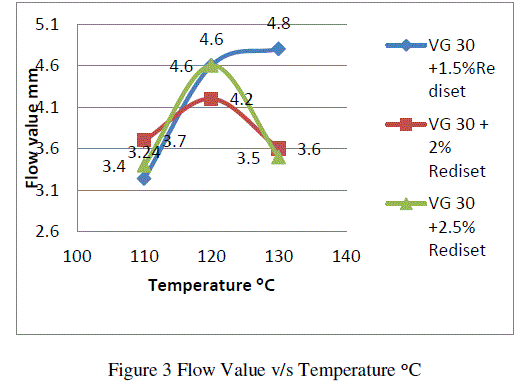ISSN ONLINE(2319-8753)PRINT(2347-6710)
ISSN ONLINE(2319-8753)PRINT(2347-6710)
Mitul Patel1, Vikas Patel1, Devendra K.Patel2, Prof.C.B.Mishra3
|
| Related article at Pubmed, Scholar Google |
Visit for more related articles at International Journal of Innovative Research in Science, Engineering and Technology
With the rise of human activity, since the beginning of the 20thcentury due to rapid rise in heavy laden vehicles on Indian roads has put pressure on it. The asphalt paving industry is constantly exploring technological improvements that will enhance the material’s performance, increase construction efficiency, conserve resources, and advance environmental stewardship. In this paper an attempt is made to use viscosity grade 30 paving mix having benefits of reducing time and cost of testing without sacrificing its quality. Viscosity grade 30 paving mix with innovative warm mix additive (Rediset) in suitable doses is prepared and tested to determine key properties of Marshall Mix design as per the provisions of codal practice. The reflection of tests suggests the strong desire to move WMA into the main stream of paving products as the production temperature is lowered benefitting the pavement construction efficiency and lowering pollution levels too.
Keywords |
| Marshall Mix, warm mix, Rediset, viscosity. |
INTRODUCTION |
| In India, rapid growth in urbanization fuelled by growth in the industrial and service sectors resulted in rapid growth of laden vehicles in limited road space to withstand high stresses with minimum maintenance. Today truck weights exceed 35 tons with 125 PSI radial tyres. The 10% increase in truck weights leads to a 40% increase in the stresses applied to the pavement and is further aggravated by heavy traffic and change in weather conditions. Therefore, to cope up with the change in conditions, there is a need to shift from 60/70 grade bitumen to Viscosity Grade 30 paving bitumen conforming to IS: 73- 2006. This reduces time and cost of testing without sacrificing its quality. VG 30 can be used in high temperature zones as it has good thermal susceptibility. |
| Warm Mix Asphalt (WMA) is one of newest technologies that allow mixing, production ≥ 30°C at which the material is mixed (110 to 130 °C), placed on the road and compaction of asphalt mixes at significantly lower temperatures due to chemical modification of the VG30 bitumen. Lower temperatures result in reduced fuel usage, fume exhausts, greenhouse gas emissions, reduces wear and tear, while enhancing worker health, safety conditions during pavement construction and lowering in construction prices while maintaining the quality of work of pavement. |
OBJECTIVES |
| The main objective is to evaluate the engineering properties of VG 30 grade bitumen and analyse the performances of it with and without WMA (Rediset) in doses of 1.5%, 2% and 2.5% samples through Marshall Test. |
LITERATURE REVIEW |
| In India, environment friendly technology is needed to reduce pollution. For Hot mix asphalt at plant and paving site, emissions from burning fuels, fumes, odours are generated more as mixing temperature is high causing more CO2. This calls for the demand of lowering mixing temperature to reduce emissions keeping in view green house effect without sacrificing the quality of the resulting pavement. Warm mix asphalt is a fast emerging new technology developed in Europe and US, now it has been recommended to carry field trials by border roads organization of India. |
| In this study, an attempt is made in the bituminous mix design using PMB 40 with Warm mix adhesion promoter to determine the laying temperature in suitable proportion, at which the material is mixed and to be placed on the prepared surface without any compromise with quality. Significant reduction in temperature have documented the obvious benefits of cutting fuel consumption, decreasing the production of green house gases and enhancing engineer benefits include better compaction on the road and the ability to haul paving mix for longer distances.[2] |
| In India, environment friendly technology is needed to reduce pollution. For Hot mix asphalt at plant and paving site, emissions from burning fuels, fumes, odours are generated more as mixing temperature is high causing more CO2. This calls for the demand of lowering mixing temperature to reduce emissions keeping in view green house effect without sacrificing the quality of the resulting pavement. Warm mix asphalt is a fast emerging new technology developed in Europe and US, now it has been recommended to carry field trials by border roads organization of India. |
| In this study, an attempt is made in the bituminous mix design using CRMB 60 with Warm mix adhesion promoter to determine the laying temperature in suitable proportion, at which the material is mixed and to be placed on the prepared surface without any compromise with quality. Significant reduction in temperature have documented the obvious benefits of cutting fuel consumption, decreasing the production of green house gases and enhancing engineer benefits include better compaction on the road and the ability to haul paving mix for longer distances.[3] |
| The WMA production temperature typically ranges from 100 to 140ºC, whereas for HMA it ranges between 150 to 170ºC. The WMA has certain distinct advantages over HMA are as the temperature level is relatively low, air-pollution caused due to emission and fumes is less. Also, the aging of asphalt binder during the heating process (called as shortterm aging) is controlled considerably. Less energy is spent while manufacturing. Temperature drop during mix transportation is no longer a concern. The construction season expands and the haul distance increases. Compacting effort is less so as to achieve a specified compaction level. |
| Various ingredients used in the WMA preparation are patented products and the respective manufacturing processes are different. Some of these processes are: |
| In one type of manufacturing process, fine powder is added which releases (upon heating) its hydration-bound water and generates foaming effect to the asphalt binder. The lubricating action keeps the mix workable at temperature range of 130-140ºC.c |
| Another suggested way of WMA production involves a two stage process. In the first stage, a specially manufactured soft asphalt binder is used which covers the aggregate surface at 100-120ºC. In the second stage, harder grade of asphalt binder is added in powder, foam or emulsion form to these precoated aggregates. The final mixture can be compacted at temperature as low as 80-90ºC. |
| In another process, organic additives are mixed with asphalt binder, which melt at about 100ºC and these chemically change the viscosity temperature behavior of asphalt binder. The mix remains workable at temperature as low as 90ºC. |
| He concluded the manufacture of WMA is simple and does not require any major modification to the hot-mix plant system. warm asphalt technology seems to be quite promising. It consumes 30% less energy, reduces carbon dioxide emission by 30%, and reduces dust emission by 50-60% compared to hot mix asphalt. This technology does not involve any major modification to the mixing plant and the construction procedure. Further research is needed so as to validate the expected field performance of such a mix specially, with reference to mix compatibility, rate of gain of structural strength after construction, rutting potential, moisture sensitivity etc.[1] |
MATERIALS AND METHODOLOGY |
Aggregates: |
| The coarse aggregates are crushed by using crusher to get varying size of aggregates from 20 mm and retained on a 2.36 mm sieve while fine aggregate shall consist 100% of fine crushed sand passing the 2.36 mm sieve and retained on 0.075mm sieve. Both coarse and fine aggregates are required for the sample should be clean, cubic shaped and rough texture to resist rutting and movements and hardness which can resist fracturing under heavy traffic loads. |
Fillers: |
| Mineral fillers have significant impact over the properties mix design. Fillers used are lime 3% and stone dust 27 % by weight of bituminous mix sample. Fillers tend to increase the stiffness of the asphalt and mortar matrix. It improves resistance to moisture, improves workability, maintains adequate amount of void in the mix and enhances the durability of mix. |
Warm Mix – Adhesion Promoter (Rediset WMX) |
| Rediset WMX Rediset WMX is a combination of cationic surfactants and organic additive based rheology modifier. It chemically modifies the bitumen and encourages active adhesion that improves the wetting of aggregates by binder. Other components of the additive reduce the viscosity of the binder at production temperature. It is in pellet form and does not contain water. By addition of 1.5%, 2.0% and 2.5% by weight of bitumen, it allows ≥ 30ºC production temperature reduction compared to HMA. |
Viscosity Grade – 30 (VG-30) |
| VG system is based on fundamental engineering parameter (not empirical). It is measured at 600C and 1350C, which takes care of both low and high temperature susceptibility of the binder. Hence, pavement engineers, contractors & consultants can have a better understanding about the binder’s performance in the field. It is used to construct extra heavy duty bitumen pavement that need to endure substantial traffic loads. Also possess excellent adhesive and bonding properties with aggregates, excellent waterproofing properties, resistance to mild acids and alkali too. |
LABORAORY TESTS |
Aggregate Test Results: |
 |
Grading of aggregates: |
 |
| From the plot of aggregate gradation chart as shown in figure 1, it shows specifically the obtained gradation line falls shows nearly the average proportion of coarse aggregate and fine aggregate which is useful for paving mix. |
Bitumen test results: |
 |
| Table 2 shows Volumetric and mechanical properties of Marshall specimens, obtained at varying binder content indicates optimum binder content of 5.5% (by weight of aggregates) satisfies the Marshall mix limit laid down in MoRTH section 508 with respect to maximum stability, flow value, bulk specific gravity, percentage air voids in compacted mix and voids filled with bitumen. |
| 1. Marshall Mix design for VG 30 (5.5 % optimum binder content) plus Rediset with optimum dosage and optimum temperature. |
| In order to obtain homogeneous mix and to achieve the required standards for attaining the quality and characteristics for pavement construction, test results of VG30 concrete mix with 5.5% optimum bitumen content is taken into consideration for mix design by addition of 1.5, 2 and 2.5% dosage of Rediset at temperature 110°C, 120°C and 130°C by weight of VG30. The results are shown in figure form. |
 |
 |
CONCLUSION |
| From the various investigations carried out in the laboraory following conclusions are drawn: |
| From the graphs, Volumetric and mechanical properties of Marshall specimens, obtained at varying binder content indicates optimum binder content of 5.5% (by weight of aggregates) satisfies the Marshall mix limit laid down in MoRTH section 508 with respect to maximum stability, flow value, bulk specific gravity, percentage air voids in compacted mix and voids filled with bitumen. |
| Laboratory Investigations to determine physical properties of VG 30 grade bitumen with and without Rediset satisfy codal practice also it is seen that dosage of 2% by weight of asphalt is acceptable for road construction as all properties are nearer to those of VG 30 grade except viscosity test which shows a sign of reflection of the quality of bond that is likely to be formed with the aggregate at lower temperature. |
| Stability test for 2% dosage of Rediset as warm mix additive is higher noted at 120ºC, air voids; voids filled with bitumen and flow value are satisfying the standards criteria’s. The important thing about warm mix as additive is significant reduction in temperature is noted without any compromise with quality of performance for flexible pavement. A reduction in the temperature of production of asphalt mixes provides energy savings, reduces asphalt oxidation and can also reduce emissions at the mix thereby decreasing the impact on the environment. Also reduction in paving temperatures increases the paving season reduces exposure of workers to harmful fumes and expands the geographical area that each hot mix plant can serve. |
References |
|